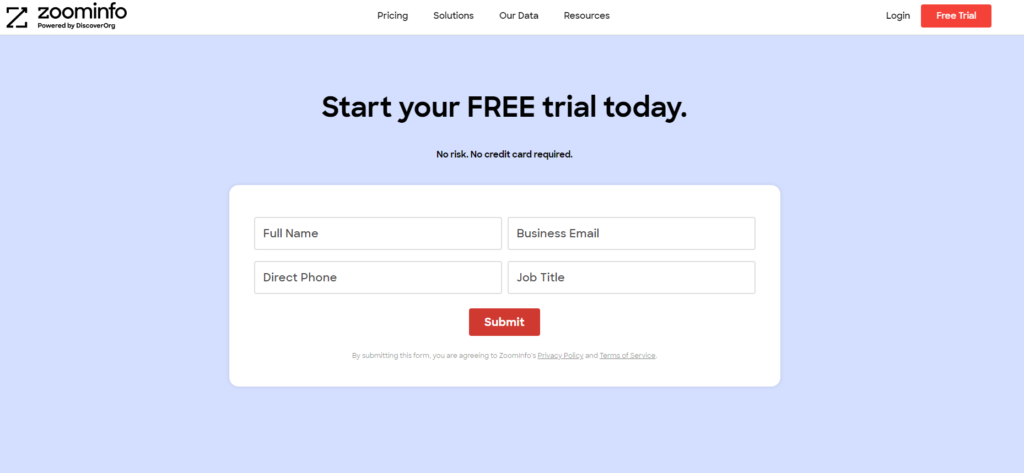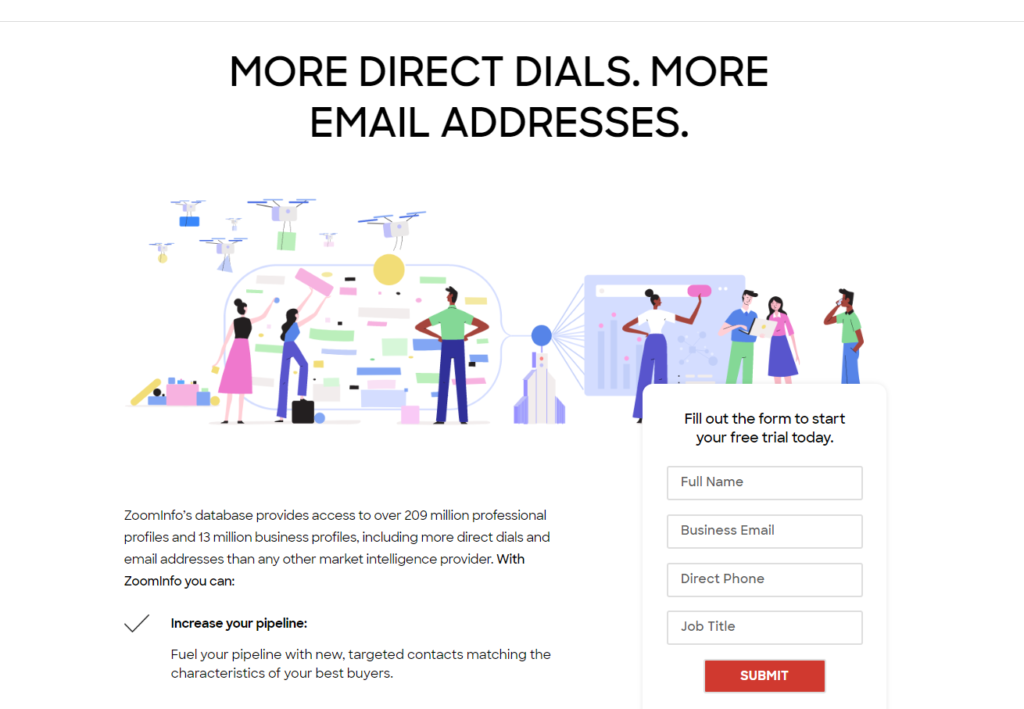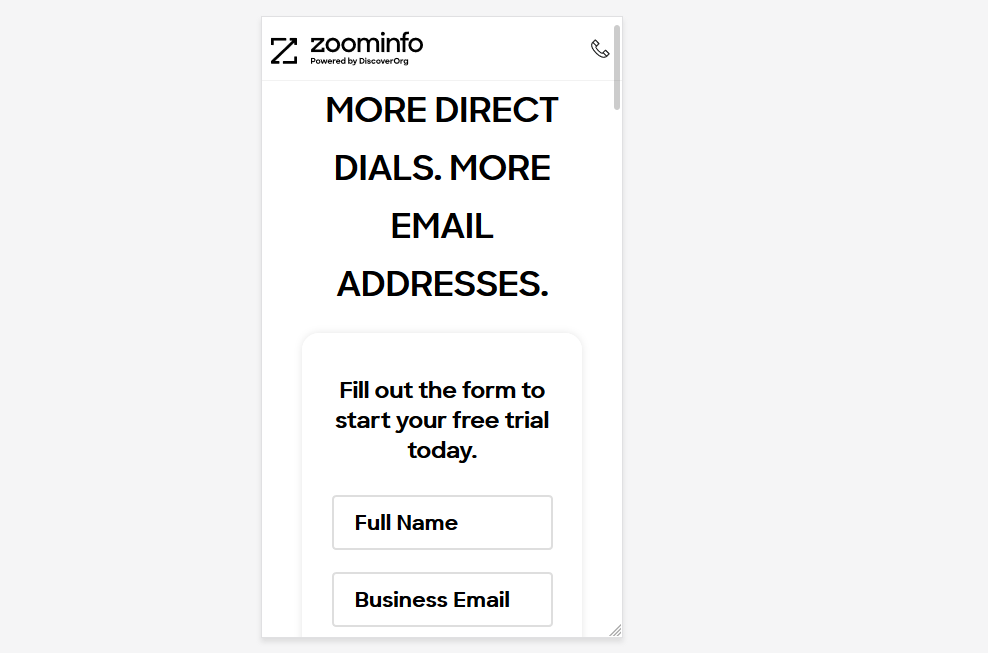Your marketing landing pages may receive a ton of traffic – but are you converting those visitors to leads? For marketers, there’s nothing more frustrating than low landing page conversion rates, especially when it’s difficult to determine what the cause is.
Likely there are many reasons why your landing pages may be suffering from low conversion rates. Marketers must consider several possibilities in order to correct their errors and create winning landing pages.
What is a Good Landing Page Conversion Rate?
If you ask this question to 10 digital marketers, you’ll likely get 10 different answers. Truth is, the answer is “it depends.” And it varies greatly based on your goals, call to action, and product.
However, if you’re just looking for a ballpark, 2-5% is a typical range and around what we usually see for our own landing pages at ZoomInfo. This is supported by WordStream, which cites a 2.35% average across industries in a detailed article about this topic.
Landing page conversion rates of more than 10% are not unheard of, though. The question is, how do you get there? And what sets those high-converting pages apart? Glad you asked.
How Can I Increase My Landing Page Conversion Rate?
1. Improve your page load speed.
Website loading speed makes a big difference. In fact, even a 1-second delay in page load time can result in a 7% reduction in conversions.
There are several factors that may slow down your landing pages. Oversized images are the most common offender. In an analysis of 18,639 landing pages, pages without oversized images led to an average conversion rate of 11.4%, compared to 9.8% for pages with oversized images.
2. Focus on one Call to Action (CTA).
Each landing page should include one direct call-to-action that tells visitors what to do next. Competing CTAs create confusion among visitors, which results in fewer leads.
Research shows that landing pages with one link led to an average conversion rate of 13.5%, while pages with two to four links led to an average conversion of 11.9%. For five or more links, conversions dropped even lower to 10.5%.

3. Give pages an authentic proof of value.
We tend to look to our peers when making big purchase decisions. Social proof refers to the idea that people gravitate towards things that are popular with others. Relevant examples of social proof include customer testimonials, case studies, and social sharing buttons.
When someone visits a landing page, social proof is often the leading factor that causes them to sign up for or purchase something. Research reveals pages that have social proof within the copy convert on average at 12.5%, compared to 11.4% for pages that don’t contain social proof.
4. Make your landing page visually interesting.
Most visitors take just a few seconds to determine whether they’ll stay on a particular page or not. For this reason, it’s important to include multimedia elements to add some life to your landing pages. Research shows using videos on landing pages can increase conversions by 86%.
Keep in mind – you should spice up your landing pages to make them more visually appealing, but don’t overdo it. Always favor a simple, clean design over a page with too many bells and whistles.

5. Optimize landing page for mobile.
Currently, mobile users spend more than double the time accessing the internet compared to desktop users.
So, if your landing pages aren’t optimized for mobile users, you will likely miss out on a significant portion of traffic. In fact, research shows mobile-friendly landing pages lead to an average conversion rate of nearly 11.7%, compared to 10.7% for desktop-only pages.
Beyond making your landing pages responsive, consider the differences in the way users interact with your site on mobile vs. desktop. Mobile pages should be more streamlined and include shorter, multiple-choice sign-up forms that are easy to complete on a mobile device.

6. Reduce text on your landing page.
Most web users scan pages rather than read them entirely. As a result, landing pages with a high word count tend to receive fewer conversions. Consider these statistics (source):
Landing pages with less copy lead to an average conversion rate of 14%, compared to 11% for landing pages with too much copy.
Landing pages in the business services sector with fewer than 100 words convert 50% more compared to pages with more than 500 words.
For this reason, we recommend that you cut down your word count and only include essential information within your copy. Also, consider text formatting. Use bullets, headers, and spacing to break up large blocks of text.
7. Ensure you’re speaking to your target audience.
Today’s buyers demand highly-personalized, specific messaging that speaks to their needs and preferences. So, no matter how great a landing page looks, it won’t convert at a high rate if it doesn’t resonate with those landing on the page.
8. Test. Test. Test.
As previously mentioned, every small detail on your landing pages can impact your conversion rate. That’s why it’s essential to test your landing pages as often as possible to gauge what is working and what isn’t. Consider these statistics on the benefits of frequent testing:
Companies that perform 50% more tests on average and use 47% more methods to improve conversion noticed improved conversion rates last year (source).
Businesses that use nine or more different optimization methods are most likely to see improvements in and increased satisfaction with conversion rates (source).
82% of companies using a structured approach to conversion rate optimization have seen improvements in conversion rates (source).
Final Thoughts about Improving Landing Page Conversion Rates
There are plenty of errors that can impact your landing pages – the above list is by no means comprehensive. But, we hope these common problems helped you identify a few improvements you can make to your own landing pages. While poor conversion rates may be frustrating, you can make a few small changes and see results quickly.
For more actionable tips to improve your landing page conversions, read the following blog post: 7 Ways to Optimize Your Lead Generation Landing Pages.
Or, contact ZoomInfo today to learn why we are the leading business information company. Don’t wait, our tools can improve your landing page conversion rates today.


